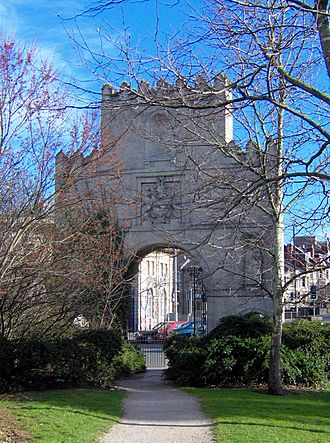Arno's Court Triumphal Arch facts for kids
Quick facts for kids Arno's Court Triumphal Arch |
|
|---|---|

Rear of Arno's Court Triumphal Arch
|
|
| General information | |
| Town or city | Bristol |
| Country | England |
| Completed | c1760 |
| Client | William Reeve |
| Design and construction | |
| Architect | James Bridges |
The Arno's Court Triumphal Arch is a cool old monument from the 1700s. You can find it in Junction Road, Brislington, Bristol, England.
About the Arch
This amazing arch was built around 1760. An architect named James Bridges designed it. He built it for William Reeve, who was a well-known local businessman.
The arch is made from a special stone called Bath stone. It looks like a classic old building. But it also has some interesting Gothic and Moorish details.
Today, the arch stands next to the main A4 road. It used to be the entrance to the Arno's Court Bath House. That building is not there anymore.
A sign on the arch tells us something important. It says the arch was moved in 1912. Its first home was at the entrance to the Black Castle. The arch was also fully fixed up in 1995.
In 1959, the arch was given a special status. It became a Grade II* listed building. This means it is a very important historical building.
Cool Carvings and Statues
The front of the arch has empty spaces called niches. These spaces once held carvings from old city gates that were torn down. The back of the arch is much simpler. It has a carving of Bristol's coat of arms. This is like the city's special symbol.
The arch also has four statues. These statues are copies made in the 1900s. The original statues were from the 1200s and 1300s.
- Two of the original statues were of King Edward I and King Edward III. These kings lived a long time ago. They were placed in deep niches on the arch's western side. These niches have cool tent-like roofs. These original statues came from Bristol's Lawfords' Gate. That gate was taken down when the arch was built.
- The other two original statues are from the 1200s. They came from Bristol's Newgate. They show Robert, who built Bristol Castle. The other is Geoffrey de Montbray, a bishop. He helped build Bristol's strong walls.
All four original statues were removed in 1898. They were getting old and damaged. Now, you can see them in the St Nicholas's Church Museum.


